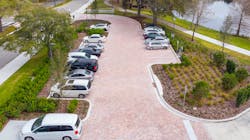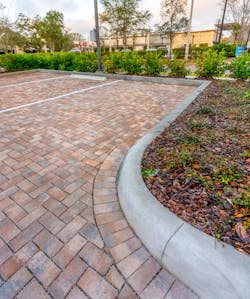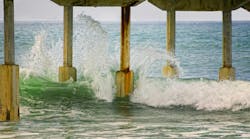The Winter Park Library in Winter Park, Fla. traces its origins to 1885, when nine women formed a lending library with books stored on one of their porches.
More than 130 years later, in December 2021, the Winter Park Library celebrated the opening of a 21st century, world-class campus designed by renowned architect Sir David Adjaye, in partnership with local firm HuntonBrady. The campus is comprised of three pavilions of rose-pigmented concrete, each raised on site for unobstructed views of Lake Mendsen. To manage stormwater and protect the quality of Lake Mendsen, engineers designed a stormwater infiltration system that included roughly 100,000 square feet of Eco-Holland Permeable Pavers by Belgard, an Oldcastle Infrastructure brand that specializes in pavers and hardscapes.
The site chosen for the new Winter Park Library was previously home to the Winter Park Civic Center with parking adjacent to Mendsen Lake, which constrained the new library development to the east. For the site to become a home for the library, the design team needed to find ways to make the site development more efficient, especially for stormwater management.
Lake Mendsen did not have the additional storage capacity that the library development would require. The site designers had to find innovative ways to meet the stormwater requirements while reducing the larger footprint. They decided that a permeable paver system would be the perfect solution to meet both the stormwater storage and water quality requirements for the site, and could be accomplished within the footprint of the proposed parking areas.
Paul Cureton, P.E., with Belgard’s commercial engineering team, provided design and technical assistance throughout the project process, including responses to comments from the St. Johns River Water Management District.
“The goal was to isolate the retention of the water as much as possible to the system, so it wouldn’t flow into the lake,” says Cureton. “Whatever water did get into Mendsen would have been filtered by the system prior, maintaining quality.”
The Belgard permeable paver system, featuring Eco-Holland pavers, was designed to meet the stormwater quality and storage requirements of the St. Johns River Water Management District, the regulatory agency reviewing the project stormwater, while providing a robust, long-lasting, and easy to maintain driving surface.
The system’s work starts when water infiltrates through the paver surface. That is where the required water treatment occurs as it filters through the aggregate between the pavers. Storage is then provided through infiltration into the native soils and in the void space in the open graded aggregate layers. The infiltration into the soil, the void space between the individual rocks, and the thickness of the stone layer is the key to providing sufficient storage and keeping all the stormwater on site and out of Lake Mendsen.
The designers chose Eco-Holland permeable pavers because they were inexpensive for the city, regionally made, and had a good color selection. Ultimately, they chose to use Napoli color because it fit the warm tones being used throughout the campus. The landscape architect liked the marbling of Napoli and the fact that it was not a solid color, and used salt and pepper granite as the joint material between the pavers to complete the look.
PaverScape, a specialty contractor, was brought in to install the system and made recommendations based on their own experience with pavers, retaining walls, and permeable applications. Jeff Wayner, project manager with PaverScape, recommended using a 90-degree herringbone pattern instead of the running bond originally considered for the project.
“With such a large space that has so much vehicle traffic, the movement of tires will naturally shift the pavers some in time — particularly in a very linear pattern such as a running bond,” he explains. “The 90-degree herringbone gives the area a better locking mechanism and will also hide slight shifts as they happen.”
Belgard performed surface infiltration testing, in accordance with ASTM C1781 Standard Test Method for Surface Infiltration Rate of Permeable Unit Pavement Systems, three months after the installation and found the infiltration rate to be 520 inches per hour. Surface infiltration rate testing is used to determine if the permeable paver system is functioning properly upon installation, and it can be performed annually to monitor the system’s function. When the surface infiltration rate has been reduced to 10 inches per hour, then restorative maintenance is required.
The testing results are being used to support adding Belgard permeable pavers to BMP Trains, a water quality design software, as an accepted water quality best management practice (BMP). The BMP Trains model was developed by the University of Central Florida, and approved and used by the Florida DOT, as well as all five Stormwater Management Districts in Florida, to model nutrient loading and nutrient reduction effectiveness of various stormwater BMPs.
The library held a community open house of the new building on December 11, 2021, including a ceremonial book transfer from the old library location to the new one. It began regular library operations two days later. SW
Published by Stormwater magazine, August 2022.







